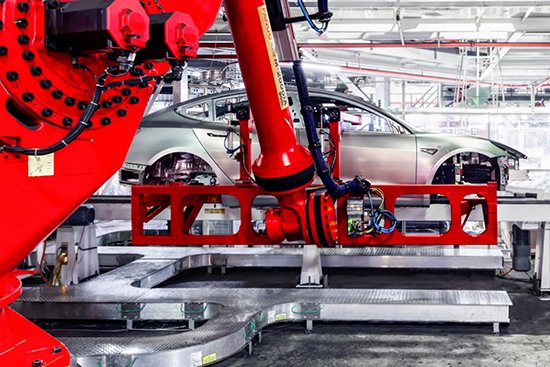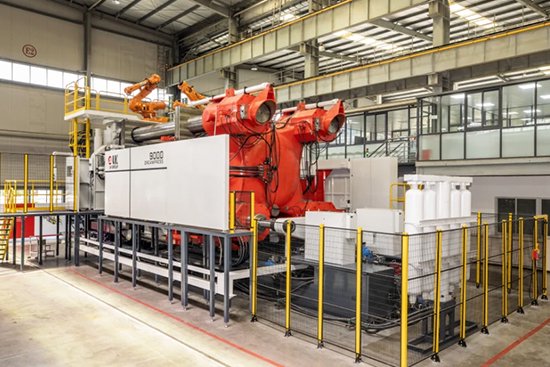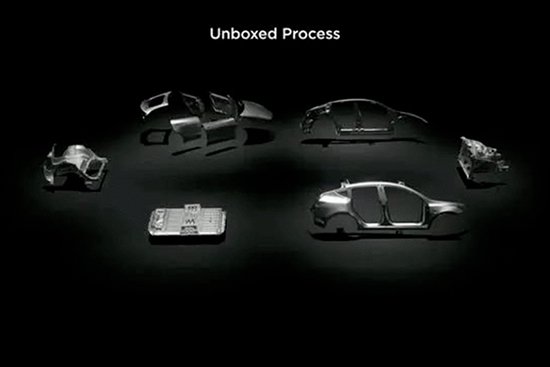前沿技术:一体化压铸将成主流技术
省时省力,改善性能 一体化压铸或将颠覆传统汽车制造

众所周知,传统汽车制造工艺包括冲压、焊装、涂装、总装四大环节。而一体化压铸技术则是将需要组装的上百个零部件,使用超大型压铸机一次压铸成型,省去了“先冲压后焊接”的传统流程,因此理论上可以将制造时间从原来的一个多小时缩短至3分钟以内。
由此来看,一体化压铸可以加速新车生产节拍,提高产能,进而缩短新车交付周期,有效解决新能源车企量产交付能力相对较差的问题,因此备受新势力品牌青睐。此外,一体化压铸还可以节省人力和工厂用地,以常规焊接车间所需要300名工人来计算,可以缩减至仅需30名左右的压铸机维修人员编制,以及减少约30%左右的焊接车间占地面积。
除了带来制造工艺方面的革新,一体化压铸对于产品性能也将产生积极推动作用。相关研究表明,新能源汽车每减少100kg重量,续航里程可提升10%-11%,还可以减少20%的电池成本以及20%的日常损耗成本。与此同时,新能源汽车的各项性能,如动力性,安全性,制动有效性等也将得到显著改善。以极氪009(配置|询价)为例,在遇到冲击时变形量减少16%,弯曲刚度提升11%,扭转刚度提升9.5%,可达36450N·m/deg,足以证明一体化压铸能够大幅提升整车刚度,提供更安全的驾驶体验。
投入和维保成本高 一体化压铸发展仍面临诸多难点

由于一体化压铸技术具备以上诸多优势,引发汽车行业的广泛关注,大量企业在这一领域进行布局。当前,国内一体化压铸产业链主要由上游压铸设备厂商、材料厂商、模具厂商,中游压铸供应商,以及下游车企组成,相关产业链日趋完善。不过,尽管国内一体化压铸技术已经具备了一定的实力和规模,但仍面临诸多难点。
首先,由于起步较晚,因此国内材料厂商所提供的基础材料与国外材料厂商存在一定差距,能否满足一体化压铸所需的强度和韧性将成为关键。同时,由于上游材料厂商需要与下游车企合作研发非标件产品,并且每个车企都有定制款,因此要对应不同车企的非标件产品进行切换,在切换的过程中可能会造成时间和运营成本的浪费。
其次,对于车企来说,不论是采用自研模式还是采购模式,前期设备投入成本均较高,包括压铸机和一体化压铸零件费用都是一笔不小的开支。其中,采用自研模式的车企需要不断加强研发和投入,提升生产工艺水平,以保证量产压铸件产品的良品率。
最后,对于消费者来说,一体化压铸所带来的更多是维保成本的增加。采用一体化压铸工艺的车辆零部件,为无传统焊接点的一个完整件,一旦损坏不能简单更换某个零件或对某一处损坏零件进行维修,必须整体更换。因此,所需维修费比传统更换单一零部件的方式更高,并且有可能导致保险费用升高。
利好消息频传 车企纷纷加码一体化压铸技术
2023年工信部等在《关于推动铸造和锻压行业高质量发展的指导意见》中明确,到2025年包括一体化压铸、轻质高强合金轻量化在内的先进铸造锻压工艺技术实现产业化应用,重点领域高端铸件、锻件产品取得突破,到2035年行业总体水平进入国际先进行列。
在国家政策支持下,一体化压铸技术已然成为大势所趋,受到越来越多新能源车企的青睐。通用汽车计划在凯迪拉克Celestiq电动轿车上使用这项工艺。沃尔沃也将在其全新的电动平台上使用一体式压铸技术,首款采用该生产技术的车型将在2025年面世。此外,国内新势力品牌蔚来、小鹏、高合,以及海外车企大众、奔驰、丰田纷纷入局一体化压铸赛道,行业渗透率快速上升。相关数据显示,目前一体化压铸技术在汽车行业的渗透率为12%,预计到2025年,我国一体化压铸市场规模将达到389亿元,其中新能源汽车一体化压铸市场规模将达到258亿元,市场空间广阔。

而在技术层面,日前特斯拉宣称实现了新突破,即车身底部可进行一体式压铸,开发一款新车的时间将缩短至18-24个月,同时造车成本也将进一步下降。与此同时,通过精简组装步骤和工艺,零部件数量和焊接点数量不断减少,零件焊接时潜在的失效率被大幅消除,产品制造的一致性和精确度也将得到进一步提升。
总结:
一体化压铸在以特斯拉为主的头部新能源汽车厂商带动下,已经取得了技术上的重大进展,为实现整车轻量化提供了切实有效的解决途径。虽然目前仍然面临着投入成本较高、材料和工艺需求复杂等困难。不过,相信随着更多汽车厂商加入,一体化压铸技术在多样化以及成本控制方面有望取得更大突破,相关产业链也将趋于更加完善和稳定。相信在双碳目标以及政策共同推动下,一体化压铸行业的市场前景将十分广阔。
In recent years, against the backdrop of the domestic automobile market becoming increasingly popular, pursuing cost reduction and efficiency improvement has become a survival strategy for many car companies, especially in the production and manufacturing field. Integrated die-casting, with its advanced manufacturing concepts, lower assembly costs, higher production efficiency, and improved vehicle safety, is regarded by many automotive companies as a magic weapon for cost reduction and efficiency enhancement, and is eagerly pursued. In 2019, Tesla first proposed integrated die-casting technology and took the lead in applying it to the Model Y (Configuration | Inquiry) model. Recently, Wenjie M9 once again raised the attention of integrated die-casting technology to an unprecedented level. The new car adopts the world's largest integrated die-casting aluminum body (9000 ton press), with an aluminum alloy content of over 80%, which is a leading position in the industry.
Time and effort saving, improved performance integrated die casting may overturn traditional automotive manufacturing
Policy Plus Car Enterprises Follow up on Integrated Die Casting Will Become Mainstream Technology
As is well known, traditional automotive manufacturing processes include four major processes: stamping, welding, painting, and final assembly. The integrated die-casting technology, on the other hand, involves using a super large die-casting machine to cast hundreds of components that need to be assembled in one go, eliminating the traditional process of "stamping before welding". Therefore, theoretically, the manufacturing time can be reduced from over an hour to less than 3 minutes.
From this perspective, integrated die-casting can accelerate the pace of new car production, improve production capacity, shorten the delivery cycle of new cars, and effectively solve the problem of relatively poor mass production and delivery capacity of new energy vehicle enterprises, which is highly favored by new power brands. In addition, integrated die-casting can also save manpower and factory land, which can be reduced to only about 30 die-casting machine maintenance personnel and approximately 30% of the welding workshop floor area, based on the requirement of 300 workers for conventional welding workshops.
In addition to bringing innovation in manufacturing processes, integrated die casting will also have a positive impact on product performance. Related studies have shown that for every 100kg weight reduction in new energy vehicles, their range can be increased by 10% -11%, and they can also reduce battery costs by 20% and daily wear and tear costs by 20%. At the same time, the performance of new energy vehicles, such as power, safety, and braking effectiveness, will also be significantly improved. Taking the extreme Kr 009 (configuration | inquiry) as an example, when encountering impact, the deformation is reduced by 16%, the bending stiffness is increased by 11%, and the torsional stiffness is increased by 9.5%, reaching 36450N · m/deg. This is enough to prove that integrated die-casting can significantly improve the vehicle's stiffness and provide a safer driving experience.
The development of integrated die-casting with high investment and maintenance costs still faces many difficulties
Policy Plus Car Enterprises Follow up on Integrated Die Casting Will Become Mainstream Technology
Due to the advantages of integrated die-casting technology mentioned above, it has attracted widespread attention in the automotive industry, and a large number of enterprises are laying out in this field. Currently, the domestic integrated die-casting industry chain is mainly composed of upstream die-casting equipment manufacturers, material manufacturers, mold manufacturers, midstream die-casting suppliers, and downstream automotive companies, and the related industry chain is becoming increasingly perfect. However, although the domestic integrated die-casting technology has already possessed certain strength and scale, it still faces many difficulties.
Firstly, due to its late start, there is a certain gap between the basic materials provided by domestic material manufacturers and foreign material manufacturers, and whether they can meet the strength and toughness required for integrated die-casting will become a key issue. At the same time, due to the need for upstream material manufacturers to collaborate with downstream automotive companies to develop non-standard products, and each automotive company has customized products, it is necessary to switch between non-standard products of different automotive companies, which may result in waste of time and operating costs during the switching process.
Secondly, for car companies, whether using self research or procurement models, the initial equipment investment cost is relatively high, including the cost of die-casting machines and integrated die-casting parts, which are not small expenses. Among them, car companies adopting the self research model need to continuously strengthen research and investment, improve production process level, and ensure the yield rate of mass produced die-casting products.
Finally, for consumers, the integration of die-casting brings more of an increase in maintenance costs. The vehicle components using integrated die-casting technology are a complete component without traditional welding points. Once damaged, it is not possible to simply replace a certain part or repair a damaged part, and must be replaced as a whole. Therefore, the required maintenance cost is higher than traditional methods of replacing a single component, and it may lead to an increase in insurance costs.
Good news spreads frequently, and car companies are adding integrated die-casting technology
In 2023, the Ministry of Industry and Information Technology and others specified in the "Guiding Opinions on Promoting the High Quality Development of the Casting and Forging Industry" that by 2025, advanced casting and forging process technologies, including integrated die casting and lightweight high-strength alloys, will achieve industrial application, and breakthroughs will be made in high-end castings and forging products in key fields. By 2035, the overall level of the industry will enter the international advanced ranks.
With the support of national policies, integrated die-casting technology has become a trend and is increasingly favored by new energy vehicle companies. General Motors plans to use this process on the Cadillac Celestiq electric sedan. Volvo will also use integrated die-casting technology on its new electric platform, and the first model to adopt this production technology will be launched in 2025. In addition, new domestic brands such as NIO, Xiaopeng, and Gaohe, as well as overseas car companies Volkswagen, Mercedes Benz, and Toyota, have entered the integrated die-casting track, leading to a rapid increase in industry penetration rate. According to relevant data, the penetration rate of integrated die-casting technology in the automotive industry is currently 12%. It is expected that by 2025, the scale of China's integrated die-casting market will reach 38.9 billion yuan, of which the scale of the new energy vehicle integrated die-casting market will reach 25.8 billion yuan, with broad market space.
Policy Plus Car Enterprises Follow up on Integrated Die Casting Will Become Mainstream Technology
In terms of technology, Tesla recently announced a new breakthrough, which is the ability to perform integrated die casting on the bottom of the car body. The time to develop a new car will be shortened to 18-24 months, and the cost of manufacturing will also further decrease. At the same time, by streamlining assembly steps and processes, the number of components and welding points continues to decrease, and the potential failure rate during component welding is greatly eliminated. The consistency and accuracy of product manufacturing will also be further improved.
Summary:
Under the leadership of leading new energy vehicle manufacturers, led by Tesla, integrated die-casting has made significant technological progress, providing a practical and effective solution for achieving vehicle lightweight. Although currently facing difficulties such as high investment costs and complex material and process requirements. However, it is believed that as more automobile manufacturers join, integrated die-casting technology is expected to achieve greater breakthroughs in diversification and cost control, and the related industry chain will also tend to be more perfect and stable. I believe that under the joint promotion of the dual carbon goals and policies, the market prospects of the integrated die-casting industry will be very broad.

